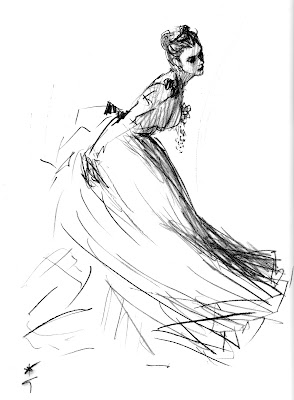Last week after finishing up my working on the blog and my daily art tasks, I rewarded myself with a trip to my favorite bookstore,The Iliad, to search for some new mystery books to read. While there I saw behind the counter the edition of the Gruau book that I used for many of the images printed here and casually asked about the price. "If it's in that cabinet, then it's at least $300." I remember buying it for $75 and thinking it was pricey, but well worth it. I guess I'm a wise investor.
I asked Bob McGinnis about this, and while he mentioned Gruau as certainly someone he was looking at and aware of, his own favorite fashion illustrator was Todd Draz. And when you look at Draz, you can see the similarities to Gruau. When I started out in comics, my heroes were Kubert, Starr, Toth, and Wood. As I matured, I discovered Robert Fawcett, and found that he was a major influence on all of them.
 |
| (A Gruau design from the 50's and below a R.M. McGinnis paperback cover from the 60's) |
 |
| (The drawing above and below by Todd Draz.) |
 |
| (Here is one of Parker's earlier works and below the simplified styles used in the 60's and 70's.) |
Coby Whitmore never seemed to leave behind the wonderful painterly
approach he took with figures, but his compositions and settings
certainly were simplified in that same period. Jon Whitcomb went through
a similar transformation, but less extreme.
 |
| (A Jon Whitcolb illustration above, and three Coby Whitmore pieces below, the latter two done in a far more graphic style.) |
Bob Peak seems to be the
most dramatically influenced by the change in fashion illustration,
which was his own background. Peak brought a graphic sensibility to his
advertising and illustration work that set the standard for the time.
 |
| (Since they both worked in the field of fashion illustration the similarities are much easier to see between Gruau's work, above, and Bob Peak's illustrations below.) |
You certainly can't exclude Jean Giraud from this discussion. He was certainly tuned into his fellow adopted countryman.
 |
| (Gruau above and Moebius (Jean Giraud) below.) |
The current leader in fashion illustration is of course, David Downton. Below are a few of the absolutely scrumptious drawings he did of Dita Von Teese. Both the freshness and spontaneity of the work and the fact that he doesn't create these digitally makes me a major fan. You might want to check out Downton's book, Masters of Fashion Illustration, for your library.
So what is it I admire about Gruau? His simplicity, his spontaneity, the drama in his compositions, his starkness of color, the elegance, and the purity of his line drawings and figures. When I look at the work it always leaves me in awe, and at the same time inspires to improve my own chicken scratches
 |
| (And one last Gruau for good measure.) |















































